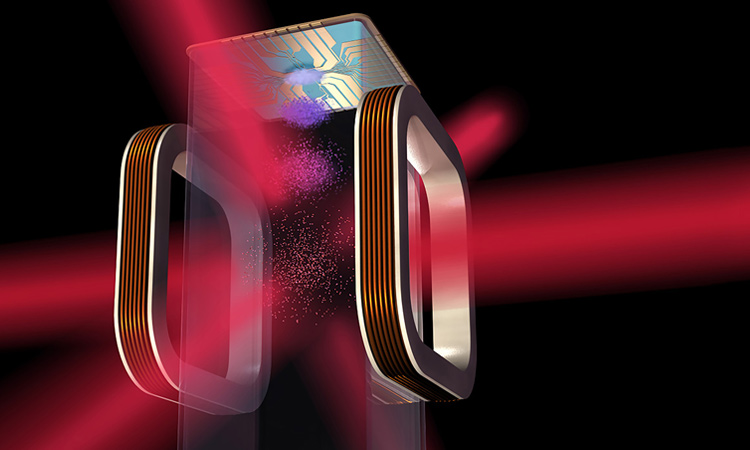 Artist’s concept of an atom chip for use by NASA’s Cold Atom Laboratory, part of whose mission is research on new quantum sensors. Meanwhile, back on Earth, efforts to commercialize such sensors are proceeding on multiple fronts. [NASA/JPL-Caltech]
Artist’s concept of an atom chip for use by NASA’s Cold Atom Laboratory, part of whose mission is research on new quantum sensors. Meanwhile, back on Earth, efforts to commercialize such sensors are proceeding on multiple fronts. [NASA/JPL-Caltech]
The world, say many experts, is on the verge of a second quantum revolution. Energy quantization gave us modern electronics via the transistor and the laser, but humans’ burgeoning ability to manipulate individual atoms and electrons could potentially transform industries ranging from communications and energy to medicine and defense. That promise has triggered major funding, with special programs in the United Kingdom and the European Union seeking to commercialize quantum technology, with a National Quantum Initiative (in which OSA is a founding partner) recently enacted in the United States, and with China and other countries poised to spend billions of dollars in the next several years on such research.
Numerous scientists working on quantum sensors have set up companies to commercialize their technology, but few have actual products on the market.
The most talked-about of such technologies is the quantum computer, a device in theory so powerful that it could crack the codes underlying internet security in just a few minutes. But full-scale quantum computers are still potentially decades away. In contrast, devices that exploit quantum phenomena to encrypt codes, rather than break them, are starting to appear on the market.
Yet many scientists believe that quantum will enjoy its first real commercial success in sensing. That’s because sensing can take advantage of the very characteristic that makes building a quantum computer so difficult: the extraordinary sensitivity of quantum states to the environment.
Whether they are responding to the gravitational pull of buried objects or picking up magnetic fields from the human brain, quantum sensors can detect a wide range of tiny signals from the world around us. Kai Bongs, a physicist at Birmingham University, U.K., believes that gravity-measuring quantum sensors in particular “will become more widespread quite quickly,” with a potential market of perhaps US$1 billion a year.
However, beyond certain niche markets, it remains to be seen how competitive quantum sensors will be. They are often bigger and more complex than their classical counterparts—which, as Franck Pereira Dos Santos of the SYRTE metrology laboratory in Paris points out, have benefited from huge investments over the years. He believes that quantum technology is sometimes oversold by those lacking real experience in building sensors. “Strong claims are sometimes made that are not realistic,” he says.
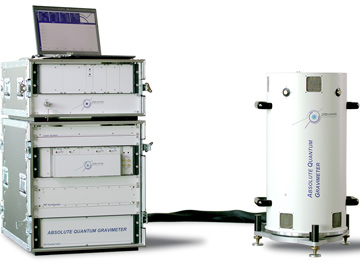 An absolute quantum gravimeter from the French company Muquans uses laser beams to measure how cold atoms fall under gravity within a 70-cm-high white cylinder. [Muquans]
An absolute quantum gravimeter from the French company Muquans uses laser beams to measure how cold atoms fall under gravity within a 70-cm-high white cylinder. [Muquans]
Mapping the underworld
Numerous scientists working on quantum sensors have set up companies to commercialize their technology, but few have actual products on the market. One that does is Muquans, on the outskirts of Bordeaux, France. Set up by colleagues of Pereira Dos Santos at SYRTE, Muquans focuses on gravimeters made from atom interferometers, which exploit the quantum-mechanical property of wave-particle duality (see sidebar, below, and “Then and Now,” OPN, June 2019).
Gravimeters allow scientists to map variations in density below the ground by recording gravitational fluctuations in both time and space. Geoscientists, for example, use these sensors to monitor volcanic hazard by measuring density changes caused by rising magma, or to gauge water resources by measuring the extent of aquifers. Energy companies, meanwhile, supplement seismic surveys by measuring variations in gravity over wide areas to look for oil and gas.
Most field-based gravity measurements currently use relative gravimeters, which monitor tiny changes in position of a mass suspended from a spring. These devices can be as sensitive as absolute gravimeters, but their output drifts over time and must be calibrated by absolute devices. As Pereira Dos Santos explains, that implies returning periodically to a reference station when carrying out a survey. “And in those surveys, time is money,” he says.
Weighty measurements
Establishing the absolute value of gravitational acceleration, g, at any point on the Earth’s surface is in principle very easy—simply measure the time and distance of a free-falling body and plug the results into a standard equation of motion. Classically, a laser beam bounced off a freefalling mirror interferes with a reference beam reflected off of a seismically isolated mirror. With the light’s wavelength providing the distance measurement and an atomic clock tracking the elapsed time, g can be measured with an accuracy of about one part in a billion.
Atom interferometers provide similar accuracy levels, but have the advantage that their test masses—the atoms—do not suffer the wear and tear of a macroscopic reflector. This reduces maintenance and speeds up measurements.
Typically, several million atoms are cooled by lasers inside a trap to just a few millionths of a degree above absolute zero before being released under gravity. During their roughly 1 m of freefall, the atoms are subject to a series of laser pulses that puts their wavefunction in a superposition of two different states; those states are then interfered with one another. The slightly different paths through the gravitational field taken by the two states sets up a phase shift between them, with the resulting interference pattern then used to determine g.
A new absolute quantum gravimeter unveiled by Muquans last year is designed to overcome these problems. Unlike its classical equivalent, it needs little or no maintenance and so can be run continuously like a relative gravimeter, while experiencing no drift. Consisting of a 70-cm-high cylinder and a slightly bigger box for the lasers and electronics, it is smaller than previous quantum devices and can be operated by non-experts. According to Muquans CEO Bruno Desruelle, the company expects to deliver two units of a more rugged version of the device to geophysicists by the end of year.
Bongs and colleagues at Birmingham are building a slightly different kind of gravity sensor to target one specific market: civil engineering. Construction companies carry out underground surveys to identify old mineshafts, sewers, sinkholes or other dangerous structures; utilities dig millions of holes in roads to locate pipes and cables. Ground-penetrating radar, while helpful, can’t see down beyond a few meters, and conventional spring-based gravimeters need several minutes to make a measurement, to average out ground vibrations that would otherwise swamp the tiny signals.
The solution, says Bongs, is a gravity gradiometer. This uses two atom clouds subject to the same external vibrations, but falling at different heights. Subtracting the signal of one cloud from the other removes the noise while revealing the gravity gradient. Although the device won’t necessarily be more sensitive to gravity than masses on a spring, it should operate much faster—cutting survey times by as much as 99%, Bongs estimates, and thereby slashing operational costs. “Our approach is not to make the best instrument,” he says, “but the most practical instrument.”
Bongs reckons that speedier measurements could transform the global market for gravity surveys in civil engineering from its current, modest US$10‒$20 million to “several hundred million” a year. He estimates that another three to five years will be needed to simplify and miniaturize the group’s existing instrument (which is currently about two meters high), and perhaps an additional five to ten years to make it cheaper than a standard gravimeter (cost: about US$100,000), although the exact timings, he says, will depend on investment by industrial partner Teledyne e2v.
A quantum compass
Atom interferometers could also be used to build navigation devices that continue to work even when contact with GPS satellites is lost, as can happen in a tunnel or, more ominously, when signals are deliberately jammed. Keeping on course in this way relies on dead reckoning, the use of accelerometers and gyroscopes to continuously update a vehicle’s position, orientation and velocity with respect to a known starting point.
Like spring gravimeters, conventional accelerometers experience drift, as their pendula warp over time. In contrast, quantum accelerometers—essentially gravimeters with their laser beams flipped along the acceleration axis—are very stable. Although the atoms’ finite free-fall time and need for preparation prevent continuous operation, which is often provided by conventional accelerometers, they enable proper calibration.
Quantum gyroscopes, meanwhile, work by generating a phase difference between atom waves propagating in opposite directions around a rotating ring. Such technology has been developed by AOSense, a company in Sunnyvale, Calif., USA, set up in 2004 by atomic physicist Mark Kasevich and two colleagues at Stanford University, USA. Often working with the U.S. military, the firm built prototype gradiometers, gyroscopes and accelerometers for the Defense Advanced Research Projects Agency (DARPA). The aim, according to a 2014 story in Physics Today, was to make inertial measurement units that could fit on a fingertip. But in the end, Kasevich says, the necessary lasers and optical modulators couldn’t be made small enough to shrink gyroscopes below “about 100 cm3.”
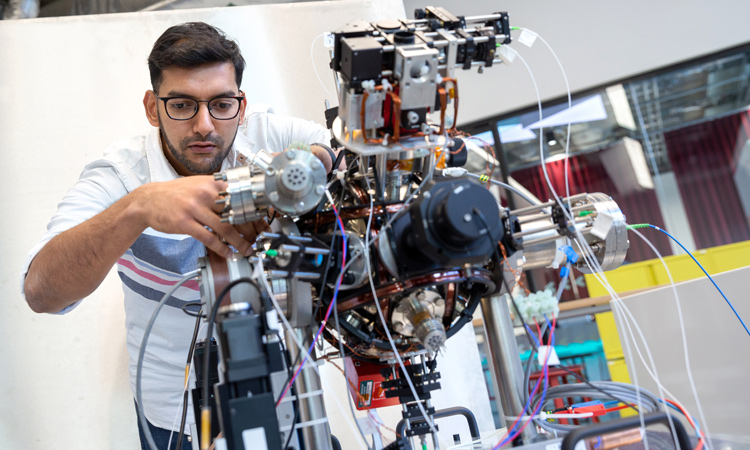 A cold-atom-based accelerometer is being developed by researchers at Imperial College London and M Squared, U.K., as part of a quantum navigation system for submarines. [Thomas Angus/Imperial College London]
A cold-atom-based accelerometer is being developed by researchers at Imperial College London and M Squared, U.K., as part of a quantum navigation system for submarines. [Thomas Angus/Imperial College London]
Undeterred, physicists at Imperial College in London and the Glasgow-based company M Squared have built what the college describes as “the U.K.’s first commercially viable quantum accelerometer, which could be used for navigation.” OSA Fellow Ed Hinds of Imperial says that the roughly cubic-meter-sized device is about 1,000 times more stable than conventional accelerometers, and should be tested on a canal boat later this year.
It is not yet clear, however, whether the technology really is commercially viable. Being developed to guide submarines of the British Royal Navy, the complete navigation system will require another two accelerometers and three gyroscopes. Hinds says that the gyroscopes will be “much harder” to build than the accelerometers, and adds that reducing the device’s size and weight “are not the pressing issues.”
Diamond lights
Making atomic sensors competitive with existing technology is “a struggle,” according to Kasevich, because the subsystems that they rely on, such as lasers and vacuum chambers, are large and complex, and have not had their costs driven down by mass markets. Trying to shrink gyroscopes in particular incurs “crazy development costs,” says Pereira Dos Santos. One option would be to guide rather than drop atoms, but that, he says, is “very exploratory … and it might never work.”
But another type of quantum technology has simple subsystems and can be built using standard materials-science techniques: nitrogen–vacancy (NV) centers. These are atom-like defects in a synthetic diamond crystal consisting of a nitrogen atom and a gap in place of two carbon atoms. NV centers can emit red light when excited by green, but the probability of doing so depends on the spin states of their electrons. By placing the spin states in a superposition, microwaves with just the right frequency can change the emission intensity.
Crucially, this quantum state can persist for up to a millisecond at room temperature, thanks to the stiff diamond lattice that shields the NV centers from vibrations. And, because changes in the local magnetic field will change the spacing of the spin states and knock the microwave frequency off-resonance—with the change proportional to the field strength—NV centers could potentially make extremely sensitive magnetometers. The system is also sensitive to variations in electric field, strain and temperature, as these change the distance between atoms and, again, shift the resonance.
Several start-up companies are looking to commercialize NV technology, in areas such as biomedicine (see “Probing neurons and tumors,” p. 30), while some multinationals are also entering the fray. These include the German engineering giant Bosch, which is building a prototype NV sensor to monitor charging and prevent excess currents in car batteries. The French electronics company Thales, meanwhile, is applying magnetic field gradients across NV diamond crystals to identify frequency components in unknown microwave spectra.
While cold-atom and NV sensors rely on superposition, some sensors are designed to exploit another strange quantum phenomenon, entanglement.
According to Thales’ head of applied quantum physics, Thierry Debuisschert, 5G network operators could use this technology, for example, to prevent interference between neighboring cell towers. But he says that it will likely take several years to overcome technical and commercial obstacles, such as working out how best to collect the faint red light emitted by the crystal. Likewise, Bosch researcher Robert Roelver says that his company probably won’t market a device for another five to ten years.
Researchers at U.S. defense firm Lockheed Martin also face hurdles in commercializing an innovative navigation instrument. The roughly foot-long NV-based device navigates by picking up tiny anomalies in the Earth’s magnetic field that have previously been mapped. Project leader Michael DiMario explains that more than five years of work have yielded “very promising results” on land, at sea and in the air—but also unforeseen problems. “I can’t really say when it will go to market,” he says.
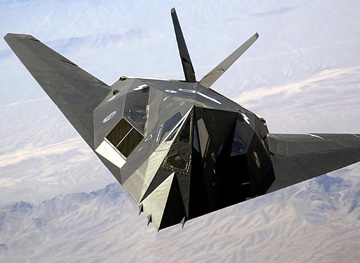 Stealth aircraft are an example of otherwise hidden objects that “quantum radar” could make detectable. [Staff Sgt. Aaron Allmon II/U.S. Air Force]
Stealth aircraft are an example of otherwise hidden objects that “quantum radar” could make detectable. [Staff Sgt. Aaron Allmon II/U.S. Air Force]
The meaning of quantum
While cold-atom and NV sensors rely on superposition, some sensors are designed to exploit another strange quantum phenomenon, entanglement. One of these technologies is quantum radar. Based on a theoretical scheme by physicist Seth Lloyd, this involves bouncing one half of a series of entangled-photon pairs off an object and then comparing the returning photons with those held back. The idea is to distinguish the radiation originally sent out from strong sources of noise, to spot otherwise undetectable objects such as stealth aircraft, and to keep the radar operators hidden.
Jonathan Baugh of the University of Waterloo in Canada is developing a near-infrared device to produce pairs of entangled photons on demand, which he says should be ready for field testing “a few years” from now. Although this will require an additional device to convert the output to microwave frequencies, it might in the end only need quantum statistics rather than entanglement per se. “If you always produce two photons at almost exactly the same time, you can use the timing correlation,” he says.
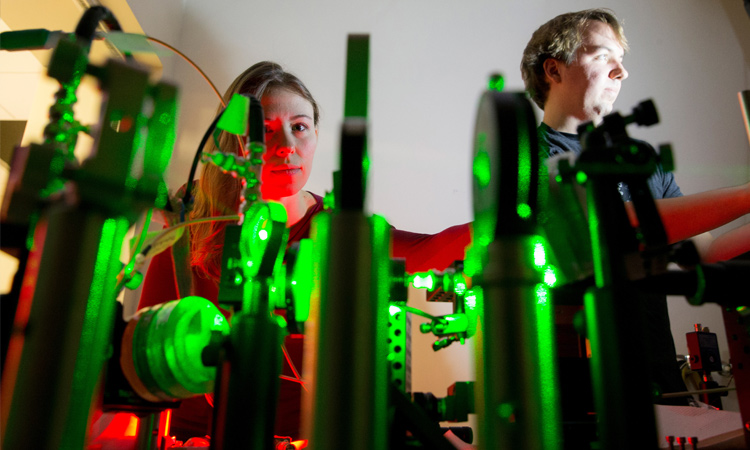 Jenny Schloss (left) and Matthew Turner at Harvard were part of a team that used NV sensors to measure magnetic fields from individual neurons inside live worms. [Rose Lincoln/Harvard Staff Photographer]
Jenny Schloss (left) and Matthew Turner at Harvard were part of a team that used NV sensors to measure magnetic fields from individual neurons inside live worms. [Rose Lincoln/Harvard Staff Photographer]
Probing neurons and tumors
By allowing extremely sensitive magnetic-field measurements, diamond nitrogen–vacancy (NV) sensors could yield new insights into the workings of the brain and body. Ronald Walsworth and colleagues at Harvard University have shown how such sensors can be used to measure the magnetic field from the electrical current flowing in individual neurons. Using a diamond wafer measuring just 4×4×0.5 mm that contained trillions of NV centers, the researchers were able to detect the fields generated by single neurons inside live worms.
Walsworth says that an array of such sensors on a person’s scalp could in principle provide a cheaper way of diagnosing conditions such as dementia, by doing away with the liquid-helium cooling and much of the magnetic shielding needed for existing detectors. But the small size of mammalian neurons means increasing sensitivity 10- to 100-fold, he says. That might be possible by collecting the emitted light more efficiently or by reducing unwanted defects in the diamond, such as nitrogen atoms not paired with vacancies.
While this work is at a fairly early stage, Walsworth and colleagues have already set up a firm to commercialize NV centers for blood analysis (using magnetic nanoparticles). Meanwhile, Martin Plenio of Ulm University and colleagues in Germany have formed the company NVision to market technology for enhancing magnetic resonance imaging. The idea is to transfer polarized spins from NV centers to nuclei used in medical imaging, given that the signal from an MRI machine is proportional to nuclear-spin polarization.
One application would involve polarizing the nuclear spins of metabolic molecules, injecting them into the body of a cancer patient and then observing how quickly they are metabolized by the tumor—which reflects malignancy. Having demonstrated the technique in a physics lab, Plenio estimates that a prototype for medical researchers might follow in a year or two. Getting approval for hospital use could take several more years, he adds.
This touches on something of a philosophical question: Just when does a technology become “quantum”? For OSA Fellow Miles Padgett, an optical physicist at Glasgow University in the U.K., the definition should, strictly speaking, involve entanglement. Indeed, he has worked on a technique known as “ghost imaging” that was originally thought to rely on entangled photons. In this scheme an optical camera is used to image an object illuminated with infrared light, by splitting pairs of visible-infrared photons that are generated from an ultraviolet laser beam sent through a crystal (see “Ghost Imaging,” OPN, October 2016).
It turns out, he says, that the photons need only be spatially correlated, rather than entangled. But he argues that the technique should still be regarded as quantum since it relies on detecting single photons. “From a more general technologist’s point of view,” he says, “as soon as you start measuring single photons or single atoms, we are talking about quantum technology.”
G whiz
This view is shared by Jay Hendricks, head of a team at the National Institute of Standards and Technology (NIST) in Gaithersburg, Md., USA, which has built a pressure sensor that in effect counts particles in a box. The device compares the pressure of cavities containing helium gas and a vacuum by measuring the beat frequency generated by laser beams fired through them. Tiny changes made to the laser frequency in the gas to maintain a resonant standing wave reflect minuscule variations in the pressure (since pressure alters refractive index). “This is one step back from truly quantum, but is based on principles that can be quantized,” he says.
Together with first-principles calculations of helium’s refractive index, Hendricks says the device, known as the fixed-length optical cavity, could serve as a pressure standard to replace bulky mercury manometers. It might also be used to calibrate pressure sensors in semiconductor foundries or as a very precise aircraft altimeter, he adds. Working with MKS Instruments of Andover, Mass., USA, his group has shrunk the cavity length to just 2.5 cm and squeezed the ancillary equipment into a couple of suitcase-sized boxes—although he can’t say when a fully marketable device might emerge.
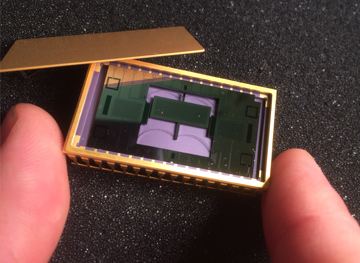 The Wee-g, a MEMS-based gravimeter that is far lighter and potentially much cheaper than conventional gravity sensors, could reach a sensitivity of 1 part in 109 by using squeezed light to overcome laser shot noise. [Richard Middlemiss]
The Wee-g, a MEMS-based gravimeter that is far lighter and potentially much cheaper than conventional gravity sensors, could reach a sensitivity of 1 part in 109 by using squeezed light to overcome laser shot noise. [Richard Middlemiss]
Back in Glasgow, a group of physicists is using quantum technology to enhance a gravimeter known as “Wee-g”—even though the sensor itself has nothing to do with cold atoms. The microelectromechanical-system (MEMS) device consists of a 12-mm-long piece of silicon suspended by four extremely thin springs. The instrument’s sensitivity, according to team member Richard Middlemiss, is “within an order of magnitude” of existing gravimeters. It is also very light (perhaps making it suitable for drone surveys), and might cost little more than £1000 (about US$1300) once the wafers are mass-produced, he says.
Middlemiss believes that the sensor could hit the market within about a year, after some 30 to 40 units have been deployed on Mt. Etna in Italy to monitor magma movement. That version of the device will use capacitors to track the tiny test mass, but later incarnations could use a laser-based technique known as squeezing to overcome shot noise, potentially raising Wee-g’s sensitivity to 1 part in 109, he says. (For more on squeezed light in quantum sensors, see this issue's tutorial “Better Sensors via Squeezed Light.”)
Padgett acknowledges that the most obviously quantum technologies may not enjoy the earliest commercial success. But he says that the U.K. technology program aims to benefit society rather than push the boundaries of fundamental physics. “Ultimately, it is that aspiration that engages the industrial base,” he says.
Ronald Walsworth at Harvard underlines this point. Instead of seeing their technology only as a “hammer” that turns every problem into “a nail to hit,” he urges his fellow scientists to think about what potential users really want. “You have to build a bridge from both sides,” he says.
Edwin Cartlidge is a freelance science journalist based in Rome.
References and Resources
-
S. Lloyd. “Enhanced sensitivity of photodetection via quantum illumination,” Science 321, 1463 (2008).
-
J.F. Barry et al. “Optical magnetic detection of single-neuron action potentials using quantum defects in diamond,” Proc. Natl. Acad. Sci. 113, 14133 (2016).
-
P.F. Egan et al. “Comparison measurements of low pressure between a laser refractometer and ultrasonic manometer,” Rev. Sci. Instrum. 87, 053113 (2016).
-
R.P. Middlemiss et al. “Measurement of the Earth tides with a MEMS gravimeter,” Nature 531, 614 (2016).
-
M. Van Camp et al. “Geophysics from terrestrial time-variable gravity measurements,” Rev. Geophys. 55, 938 (2017).
-
V. Ménoret et al. “Gravity measurements below 10−9 g with a transportable absolute quantum gravimeter,” Sci. Reports 8, 12300 (2018).
